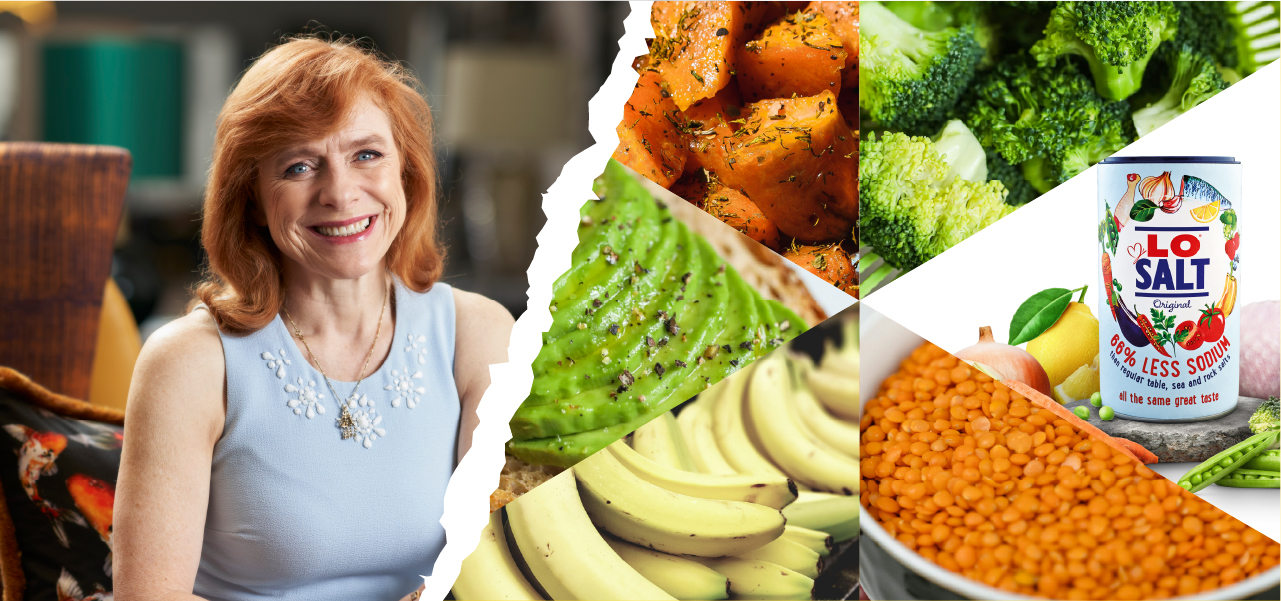20 November 2024

The Positive Impact of a Potassium-Enriched Diet
Latest guidance from the European Society for Cardiology highlights the health benefits of increasing the potassium in your diet – Dr Sarah Jarvis explains more
Most of us remember potassium and sodium from our chemistry lessons at school – but many of us haven’t given them a thought since then. In fact, they’re both essential nutrients which are kept in careful balance by our bodies. They help control fluid balance, nerve and muscle function, blood pressure and more.
Why the worry about sodium?
But it’s well known among doctors that too much sodium – mostly in the shape of salt – is one of the major drivers for high blood pressure. Since raised blood pressure is one of the biggest risk factors for heart attack and stroke, this matters – a lot.
In fact, Public Health England describes excess (sodium-rich) salt in the diet as ‘one of the most important modifiable risk factors for high blood pressure’1. The Department of Health estimates that if all of us cut our average daily intake of salt by one gram a day, we could prevent over 4000 premature deaths a year1.
Potassium and your heart
One way of cutting sodium in your diet is to replace ‘normal’ salt (which includes table salt, sea salt rock salt and pink Himalayan salt) with reduced sodium alternatives, such as LoSalt. LoSalt has 66% less sodium than regular salt, and it’s made by replacing much of the sodium with potassium.
But potassium does much more than fill in the gaps for sodium. The latest guidance from the European Society for Cardiology highlights2 the health benefits of increasing the potassium in your diet. They point out that increasing the potassium in your diet can cut your risk of heart attack and stroke. Actively cutting down on regular salt and replacing it with potassium-enriched salt substitutes has been shown to reduce the risk of cardiovascular disease (mostly heart attack and stroke).
The guidance goes on to point out that optimizing your potassium intake (including by eating lots of fruit and veg) can lower your blood pressure. The World Health Organization (WHO) recommends3 most people should have over 3.5 grams of potassium in their diets every day. The exceptions are people with advanced chronic kidney disease, or people taking medications which can cause the potassium in their system to rise.
Other health benefits of potassium
Potassium is involved in countless processes going on in your cells. It can help move nutrients into – and waste products out of – your cells. It also has an important role to play in helping your muscles contract efficiently and keeping messages moving between nerves and other parts of your body.
Potassium also helps keep the acid-base balance in your body at the right level. It may also help keep the levels of calcium (essential for bone health) topped up. These effects may be why it is thought to help improve bone strength4 – one of the ways to guard against osteoporosis, or thinning of the bone.
The relationship between calcium and potassium may also explain why a diet high in potassium can help protect against kidney stones4.
How can I increase my potassium intake?
Studies have shown that more than half the potassium in our diets comes from ‘minimally processed foods’. These are foods that still retain most of their nutritional value, such as frozen or canned fruit and vegetables, plain mild, wholewheat flour.
Shifting towards a more plant-based diet is well proven to be good for your heart health. And it is no coincidence that plant-based diets are rich in potassium. For instance, the following foods are highlighted by the European Society of Cardiology guidelines as providing good sources of potassium:
- A medium banana (450mg potassium)
- A cup of unsalted boiled spinach (840mg potassium)
- A cup of mashed avocado (710mg potassium)
Other good sources include:
- Baked potatoes
- Dried apricots
- Soybeans
- Many beans, lentils and pulses
- Broccoli
- Sweet potatoes
- Peas
- Courgettes
The same guidance specifically calls out the potential benefits of substituting potassium-enriched salts to increase potassium intake and cut sodium intake. They recommend this for people with high blood pressure who don’t have moderate-severe chronic kidney disease.
References
1 Public Health England. Health Matters: Combatting High Blood Pressure; 2017 (https://www.gov.uk/government/publications/health-matters-combating-high-blood-pressure/health-matters-combating-high-blood-pressure )
2 McEvoy et al. ESC Guidelines for the management of elevated blood pressure and hypertension. European Heart Journal, Volume 45, Issue 38, 7 October 2024, Pages 3912–4018 (https://doi.org/10.1093/eurheartj/ehae178)
3 WHO. Guideline: Potassium intake for adults and children. Geneva: World Health Organization; 2012.
(https://www.who.int/publications/i/item/9789241504829)
4 Connie M. Weaver. Potassium and Health. Advances in Nutrition, Volume 4, Issue 3, 2013,Pages 368S-377S, ISSN 2161-8313 (https://www.sciencedirect.com/science/article/pii/S2161831322011279)
5 Bolton KA, et al. Dietary Intake and Sources of Potassium in a Cross-Sectional Study of Australian Adults. Nutrients. 2019 Dec 6;11(12):2996. (https://pubmed.ncbi.nlm.nih.gov/31817767/)
